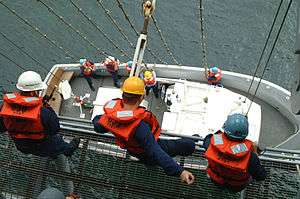Captain's gig

The captain's gig /ˈɡɪɡ/ is a boat used on naval ships as the captain's taxi. It is a catch-all phrase for this type of craft and over the years it has gradually increased in size, changed with the advent of new technologies for locomotion, and been crafted from increasingly more durable materials.
History
Wooden captains' gigs

In general, during the era of wooden ships, it was smaller and lighter than the longboat, barge or pinnace. It was usually crewed by four oarsmen, and a coxswain. Generally the oarsmen sat one to a seat, but each only rowed a single oar on alternating sides. The gig was not as sea kindly as the longboat, but was used mostly in harbors.
The gigs generally had a high wineglass transom, full skeg, full keel, straight stem and somewhat rounded sides. There was in general very little rocker in the keel. The gunwales on many were nearly straight from bow to stern. It appears to be the precursor to the Whitehall Rowboat. Some wooden captain's gigs were quite large and were powered by sail.
Modern captains' gigs
.jpg)
With the coming of metal ships and combustion engines the size of the captain's gig increased and the boats could transport more sailors swiftly. Some modern built craft with sails have been named captain's gig as well.
In the U.S. Navy, the Captain's Gig varied by the size of the ship, with aircraft carriers and, until the mid-1990s when they were decommissioned, battleships, typically assigned a double cabin cruiser that was 33 to 35 feet in length. These boats were typically painted with a white superstructure and gray hull with a red waterline stripe and black hull below the waterline. They would also frequently have the parent ship's hull number marked on the port and starboard bows and/or the name of the parent vessel emblazoned astern. Because these capital ships also held a dual function as flagships for an embarked admiral, an identical vessel, albeit painted with a black hull and green waterline stripe functioned as an admiral's barge, with the flag officer's rank stars and/or organizational title abbreviated on the bow and a longer length organizational title emblazoned astern. In early 2008, in an economy move, Captain's Gigs were eliminated from all U.S. Navy aircraft carriers.[1]
In popular culture
- In science fiction, the term is often used to refer to a small auxiliary spacecraft. In Star Trek, the craft are referred to as a "captain's yacht".
See also
- Cornish pilot gig, a larger boat (crewed by 6 plus a cox) which used to be used to transport pilots out to ships.